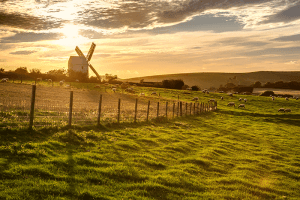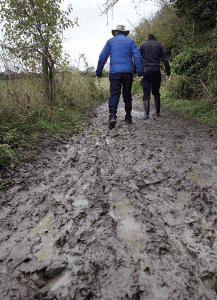Turkey is a traditional favourite but there are so many choices of meat when it comes to the festive table, and many excellent local producers
What scene depicts Christmas more traditionally than a large cooked bird being brought out to the table and carved by the head of the household?
Turkey is, of course, still the popular festive choice. Tom Copas Jnr says: “Turkey is what you’re meant to have! We’ve been rearing the best turkeys in Britain for over 60 years and nothing tastes better on Christmas Day, especially knowing all the care and attention that’s gone into their welfare.” Visit www.copasturkeys.co.uk
For minimal stress, it’s important to plan your Christmas catering about now in the manner of a military operation. Ideally, place your order by 1st December and remember your butcher can help decide how big your roast needs be. As a rule of thumb, a 10lb turkey will feed between eight and 10 people and still give you leftovers. Tell your butcher not only how many guests you have, but how big an appetite they have to judge wisely.
“Talking to our customers, it’s become clear that many are looking for something a little different from the traditional turkey this year and we’re very pleased to oblige,” says Calumn Connelly of The Hungry Guest Butchers in Petworth. “The Goodwood rib of beef roast, or venison from the Merryworth Estate are delicious alternatives, looking wonderful as they’re served, and offering a glimpse back to older English traditions. There are, of course, many for whom turkey remains the centrepiece of the Christmas table; and alongside an offering of the finest whole birds, there’s the option of rolled turkey which is easier to prepare and serve, or a memorable three-bird roast. The Creedy Carver chickens and ducks used for these also make perfect alternatives for smaller households; and our homemade pigs in blankets will complement your meal, whichever roast you prefer!” Visit www.thehungryguest.com


Recipe queen Lyn Deveson says: “I’ve always cooked turkey and a gammon; cold turkey, ham, turkey curried, stir fried, in sandwiches is a big part of the appeal. But I cooked a cockerel last Christmas and won’t go back to turkey – it has more flavour. I remember my mother cooking the turkey all night on a low heat but the French way is best; higher heat and less time. People complain it can be dry but if cooked properly, it isn’t. Good gravy makes all the difference, too!
“I also remember my mother cooking the turkey all night on a low heat, but the French way is best – higher heat and less time. People complain it can be dry but if cooked properly, it isn’t. Traditionally we cook turkey, stuffing, bread sauce, sausages wrapped in bacon etc. with the head male at the top of the table, carving! That’s the picture we all have in our heads and everyone wearing paper hats and pulling crackers! Because turkey meat can be quite bland, you can go to town with the other flavours. A good gravy makes the difference and thanks to chefs such as Jamie Oliver, we are learning that Bisto is not the essential ingredient but I am shocked by the number of English who still use it! The trouble is we are so spoilt nowadays and can eat anything any time of the year, so Christmas lunch or dinner isn’t such a treat as it used to be.”
Hungerford master butcher Christian Alba says: “In all the places I’ve worked, most of the Christmas meat customers buy is turkey. But I grew up on a turkey farm, so I have beef fore rib!”

Enter our competition for a Christmas In A Box foodie hamper – including a 6kg turkey!






 Old Winchester Hill is a scheduled ancient monument with an Iron Age Hill Fort, a Bronze Age cemetery and is also a National Nature Reserve. It’s one of the most iconic hills in the National Park. But the route up to it becomes a slippery kilometre of boot-churned mud every winter. Being inaccessible to machinery and vehicles makes it a great place to be (when it’s dry) but almost impossible to reach to fix. What is needed is £50,000 to scrape away the mud and replace the surface with stones.
Old Winchester Hill is a scheduled ancient monument with an Iron Age Hill Fort, a Bronze Age cemetery and is also a National Nature Reserve. It’s one of the most iconic hills in the National Park. But the route up to it becomes a slippery kilometre of boot-churned mud every winter. Being inaccessible to machinery and vehicles makes it a great place to be (when it’s dry) but almost impossible to reach to fix. What is needed is £50,000 to scrape away the mud and replace the surface with stones.